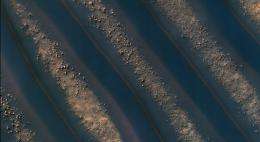Dunes of Sand: Resumed Mars Orbiter Observations Yield Stunning Views

(PhysOrg.com) -- Dunes of sand-sized materials have been trapped on the floors of many Martian craters. This view shows dunes inside a crater in Noachis Terra, west of the giant Hellas impact basin in Mars' southern hemisphere.
The High Resolution Imaging Science Experiment (HiRISE) camera on NASA's Mars Reconnaissance Orbiter captured this view on Dec. 28, 2009. The orbiter resumed making observations in mid-December following a three-month hiatus.
A set of new images from the HiRISE camera is on the camera team's site, at hirise.lpl.arizona.edu/nea.php .
The dunes here are linear, thought to be due to shifting wind directions. In places, each dune is remarkably similar to adjacent dunes, including a reddish (or dust-colored) band on northeast-facing slopes. Large angular boulders litter the floor between dunes.
The most extensive linear dune fields known in the solar system are on Saturn's large moon Titan. Titan has a very different environment and composition, so at meter-scale resolution they probably are very different from Martian dunes.
Provided by JPL/NASA




















